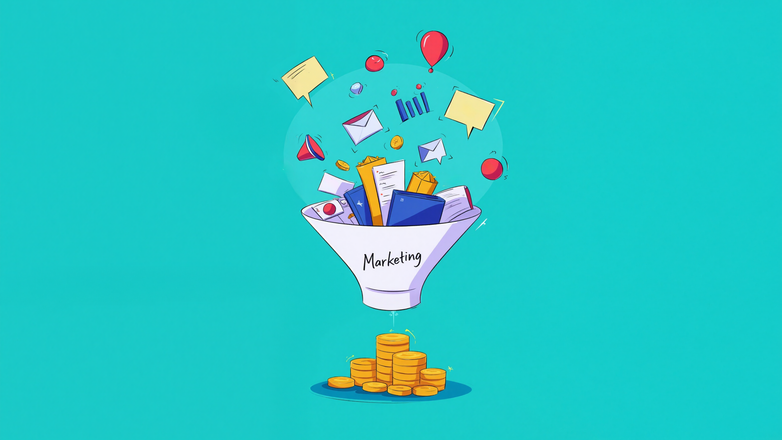At Belkins, the marketing contribution to the sales pipeline is almost 70%, but it hovers at around 25–59% for most other companies.
I’m positive you’d have preferred a single and direct answer. However, giving one is impossible since, as our experience of working with hundreds of companies shows, marketing’s contribution to the sales pipeline depends on various factors.
Key influences include:
- Company size and industry. Larger enterprises and niche industries often see higher marketing contributions due to their sophisticated campaigns and broader market reach.
- Go-to-market strategies. Inbound and product-led strategies rely heavily on marketing expertise to attract and engage prospects. As a result, marketing is expected to play a larger role in contributing to the sales pipeline in these scenarios.
- Season. In a down economy or recession, marketing will be expected to contribute more to the sales pipeline. However, if a company hasn’t built its brand prior to the economic downturn in question, marketing won’t be able to do much.
- Revenue. Companies with more revenue will have more resources to support their marketing initiatives.
| Revenue | Type | Marketing contribution |
| <$5M | Small business | 25% |
| $5M–$20M | Small to lower-medium-scale business | 27% |
| $20M–$50M | Medium-scale business | 29% |
| >$50M | Mature organizations | 28% |
The above marketing contribution benchmark is based on LeanData’s survey of 311 respondents, in collaboration with Salesforce, Atrium, Clearbit, Modern Sales Pros, and RevOps Squared. However, there are two nuances to consider regarding this data.
Revenue maturity
The revenue maturity of a company can impact what executives expect marketing to contribute to its sales pipeline, as well as their perspective on how to build a pipeline.
LeanData estimates the marketing contribution for enterprises making over $50M to be 28%. Dave Kellogg, a former director of companies with revenue reaching millions and a billion, disagrees. According to Dave, a reasonable marketing contribution for a $50M company should be 50% (plus or minus 10%). However, this figure can vary widely.
“I’ve seen companies where marketing generates 95% of the pipeline and those where it generates almost none,” says Dave.
In a separate report, Insights Squared supports Dave’s benchmarks, revealing that marketing contributes an average of 53% to the sales pipelines of companies with over $50M in revenue. This 53% tilts one way or the other depending on the company’s average selling price (ASP).
For companies with over $50M in revenue and an ASP under $50K, the marketing contribution to the sales pipeline stood at 59%. However, similar companies with an ASP over $50K had a lesser marketing contribution of 47%.
We can attribute the difference in marketing contributions to the sales pipeline based on ASP to two major factors:
- Customer acquisition complexity. For companies with an ASP under $50K, the sales cycle is less complex, making marketing’s role in generating and nurturing leads more prominent. Marketing often drives a larger portion of the pipeline through scalable efforts like digital campaigns, inbound strategies, and automated outreach.
- Sales-led focus on products with higher ASP. Companies with an ASP over $50K typically deal with more complex sales processes, often involving longer cycles and high-touch interactions with senior decision-makers. These companies may rely more heavily on outbound sales efforts, partner ecosystems, and direct sales interactions, which reduces the relative percentage of the pipeline contribution from marketing.
Company stage
The percentage of a marketing-sourced pipeline also depends on the company’s stage.
When we started Belkins in 2017, our founders had to source the pipeline and rely almost solely on their outreach efforts. Marketing’s role was minimal and performed a support function because of the limited resources we had available.
However, as the company’s annual revenue surpassed $10M, having served over 1,000 companies across 50+ industries, marketing’s contribution to our sales pipeline took a central role. The aim was to drive more awareness about the company, position Belkins as the #1 brand for sales outsourcing and appointment setting, and help us move into new and underserved segments with a higher average deal size and lifetime value.
Demand generation tactics that contribute to the marketing-sourced pipeline
Irrespective of a company’s stage, revenue, or GTM strategy, there are some basic tactics one can’t do without — SEO, content, social media publishing, and email nurture to name a few.

Insights Squared research supports this, saying, “Direct/organic search (driven by SEO and content), paid digital [ads], virtual events, and in-person events drive 83% of the marketing-sourced pipeline.” The information for LeanData is even more granular:
- 36% of companies say SEO delivers between 11–30% of the total sales pipeline
- 6% of companies report paid search or SEM delivers over 30% of the total sales pipeline, and 46% report it delivers 11–30% of the total sales pipeline
- 50% of companies say organic social traffic delivers 5% or less of the total sales pipeline and 5% of companies report it delivers 41–50% of the total sales pipeline
- 17% report that paid social delivers 21–40% of the total sales pipeline, 10 points higher than that of organic social
The data clearly shows that results vary for different companies by channel or tactic. So whether your company generates under $5M or over $50M in revenue, you should create a strategy that prioritizes a few core tactics. As the business grows, you’ll saturate each tactic and channel and have increased revenue to explore others.

Building a scalable marketing-sourced pipeline
Your company’s stage, revenue, and industry saturation, as well as the saturation of channels by your competitors, will impact your ability to build a scalable pipeline. That’s why you should note down these pipeline benchmarks: to get an idea of what works.
These are not one-size-fits-all solutions, but from our experience, if your product is excellent or your service is top-quality, your brand will promote itself, and marketing’s contribution to the pipeline will become easier. We’ve experienced this at Belkins, leading us to develop an ambitious plan to become a $100M company by 2030. Besides utilizing other strategies for achieving this goal, we’ll be relying on our tried-and-tested tips for generating a marketing pipeline:
- We’ll build on our organic demand powerhouse by publishing more bottom-of-the-funnel SEO content and creating more case studies and research reports.
- We’ll run paid ads to retarget potential customers.
- We’ll continue cementing our brand as the #1 industry leader by publishing LinkedIn content and appearing on relevant industry podcasts.
- We’ll continue to include events in our strategy by hosting webinars, podcasts, and live events featuring industry experts.
- We’ll grow our community of sales professionals to gain mindshare and further raise awareness about Belkins.
Lastly, we must state that none of these will work if there’s no thorough understanding of your target audience or ideal customer. Your team must know this information to create a consistent message that drives a quality pipeline that converts.
📚 Relevant reading:

